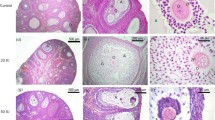Summary
The ultrastructural characteristics of the ovarian medulla of the newly hatched white leghorn chick were studied in control animals and compared with chicks that were treated with human chorionic gonadotropin during embryonic development. The ovarian medulla was mainly occupied by epithelial cells which formed cords or islets surrounded by a basal lamina. Within this epithelial compartment, steroidogenic cells, poorly differentiated cells and a lacunary system could be recognized. When chicks were treated with human chorionic gonadotropin, steroidogenic cells became discernible; there was an increment in the amount of cytoplasm and the area of mitochondria. Poorly differentiated cells exhibited signs of stimulation, and transitional images suggested the transformation of these cells into steroidogenic cells. The epithelial cells of the lacunar system also displayed stimulated cytoplasmic organelles. Evidence was supplied suggesting that relatively undifferentiated cells persist in the ovarian medulla until hatching and can develop into steroidogenic cells under gonadotropic stimulation.
Similar content being viewed by others
References
Blanchette EJ (1966) Ovarian steroid cells II The lutein cell. J Cell Biol 31:517–542
Callebaut M (1979) The avian embryo is an open organ. Anat Embryol 158:103–119
Christensen AK (1965) The fine structure of testicular interstitial cells in guinea pig. J Cell Biol 26:911–935
Dahl E (1971) Studies of the fine structure of ovarian interstitial tissue. 5. Effects of gonadotropins on the thecal gland of domestic fowl. Z Zellforsch 113:133–156
Firket J (1914) Recherches sur l'organogenèse des glandes sexuelles chez les oiseaux. Arch Biol Paris 29:201–351
Galli FE, Wassermann GF (1973) Steroid biosynthesis by gonads of 7- and 10-day-old chick embryos. Gen Comp Endocrinol 21:77–83
González CB, Charreau EH, Lantos CP, Aragonés A, Follett BK (1985) Parámetros hormonales hipófiso-gonadales en el embrión de polio hembra. Medicina 45:418
González-Morán G, González del Pliego M, Pedernera E (1985) Morphological changes in the ovary of newly hatched chickens treated with chorionic gonadotropin during embryonic development. Gen Comp Endocrinol 59:162–167
Guichard A, Cedard E, Haffen K (1973) Aspect comparatif de la synthèse de stéroïdes sexuels par les gonades embryonnaires de poulet à differents stades du développement (étude en culture organotypique à partir de précurseurs radioactifs). Gen Comp Endocrinol 20:16–28
Guichard A, Haffen K, Cedard L, Mignot Th-M, Scheib D (1979) Effects of hCG and of season on “in vitro” steroidogenesis by 18-day chick embryo gonads. Ann Biol Anim Biochem Biophys 19:1317–1325
Haffen K, Cedard E (1968) Etude en culture organotypique “in vitro”, du metabolism de la déhydroépiandrosterone et de la testosterone radioactives, par les gonades normales et intersexuées de l'embryon de poulet. Gen Comp Endocrinol 11:220–234
Jordanov J, Angelova P, Boyadjieva-Michailova A, Bakalska M (1978) Ultrastructure of developing interstitial cells in chick embryonic gonad in relation to their genesis and steroidogenic function. Z Mikrosk Anat Forsch 92:449–464
Mori H, Christensen K (1980) Morphometric analysis of Leydig cells in the normal rat testis. J Cell Biol 84:340–354
Narbaitz R, Adler R (1966) Submicroscopical observations on the differentiation of chick gonads. J Embryol Exp Morphol 16:41–47
Narbaitz R, Kolodny L (1964) Δ5–3β hydroxysteroid dehydrogenase in differentiating chick gonads. Z Zellforsch 59:1–5
Reynolds ES (1963) The use of lead citrate at high pH as an electron-opaque stain in electron microscopy. J Cell Biol 17:208–209
Scheib D, Haffen K (1967) Etude histochimique de la 3β-hydroxystéroïde déshydrogénase dans les jeunes gonades embryonnaires de poulet. CR Acad Sci Ser D 264:161–164
Stahl A, Carlon N (1973) Morphogenèse des cordons sexuels et signification de la gonade chez l'embryon de poulet. Acta Anat 85:248–274
Teng CT, Teng CS (1977) Studies of sex organ development. The hormonal regulation of steroidogenesis and adenosine 3′5′ cyclic monophosphate in embryonic chick ovary. Biochem J 162:123–134
Weniger JP, Zeis A (1971) Biosynthèse d'oestrogènes par les ébauches gonadiques de poulet. Gen Comp Endocrinol 16:391–397
Woods JE, Weeks RL (1969) Ontogenesis of the pituitary-gonadal axis in the chick embryo. Gen Comp Endocrinol 13:242–254
Woods JE, Mennella JA, Thomas RC (1981) The hypothalamicadenohypophyseal-gonadal axes in the developing chick embryo. Gen Comp Endocrinol 45:66–73
Zirkin BR, Dykman DD, Kromann N, Cochran RC, Ewing LL (1982) Inhibition and recovery of testosterone secretion in rats are tightly coupled to quantitative changes in Leydig cells smooth endoplasmic reticulum. Ann NY Acad Sci 383:17–28
Author information
Authors and Affiliations
Rights and permissions
About this article
Cite this article
del Pliego, M.G., González-Morán, G. & Pedernera, E. Ultrastructure of the ovarian medulla in the newly hatched chick treated with human chorionic gonadotropin. Cell Tissue Res. 253, 665–670 (1988). https://doi.org/10.1007/BF00219758
Accepted:
Issue Date:
DOI: https://doi.org/10.1007/BF00219758




